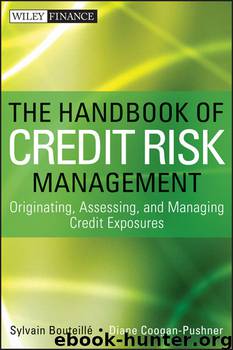The Handbook of Credit Risk Management: Originating, Assessing, and Managing Credit Exposures by Sylvain Bouteillé & Diane Coogan-Pushner

Author:Sylvain Bouteillé & Diane Coogan-Pushner
Language: eng
Format: epub
ISBN: 9781118421468
Publisher: Wiley
Published: 2012-12-04T16:00:00+00:00
ORGANIZATIONAL SET-UP AND STAFFING
Credit portfolio management is either a corporate function attached to the chief risk officer or part of a business unit like investment banking or capital markets, and, thus, it either has a P&L responsibility or contributes to one. The latter case is found in institutions that, in addition to the transfer pricing and incentive alignment requirements, are so diversified (e.g., active in commercial banking, investment banking, and asset management) that it makes more sense to have CPM specialists reporting to people who understand what they do. In all cases, they are independent from the origination units, the same way the credit risk assessment team is. Contrary to the risk-assessment team though, CPM interacts only infrequently with the business units because they are not involved in individual transactions.
A large part of what CPM does is analytical in nature, so a large number of staff will have strong quantitative backgrounds. Hedging transactions are executed via the internal trading desk, if there is one. Otherwise, CPM deals with external dealers.
Chinese Walls and Nonpublic Information
In case an institution has access to nonpublic information, it has to be careful when it executes hedging transactions. It is illegal to execute certain financial transactions based on information that not all market participants have, because this may constitute insider trading. Prosecutors all over the world are harsher and harsher with traders gaining from privileged access to material nonpublic information.
A firm in regular contact with its clients and counterparties has routine access to information that is not shared with the public. It is legitimate for a borrower or client to disclose nonpublic financial statements and other relevant information in the deal origination process. It is also fine for a firm to make a credit decision based on what it knows. Problems occur when the CPM team has access to material nonpublic information and uses this private information to hedge an exposure.
Firms wanting the flexibility to hedge some of their positions need, therefore, to isolate the staff deciding on new transactions from the staff that may be buying protection or selling the risk back to the market—that is, “Chinese walls” have to be built. Banks refer to the “private side” and the “public side” of the business. This can lead to the duplication of certain functions like credit assessment. Two separate teams are in charge of assessing the credit quality of counterparties. The one on the private side receives private information and recommends accepting or declining a credit exposure based on what they know. The CPM is on the public side and relies exclusively on public information as the basis for recommending hedging some exposures.
Download
This site does not store any files on its server. We only index and link to content provided by other sites. Please contact the content providers to delete copyright contents if any and email us, we'll remove relevant links or contents immediately.
The Black Swan by Nassim Nicholas Taleb(6761)
Bad Blood by John Carreyrou(6271)
Pioneering Portfolio Management by David F. Swensen(6078)
Millionaire: The Philanderer, Gambler, and Duelist Who Invented Modern Finance by Janet Gleeson(4089)
Skin in the Game by Nassim Nicholas Taleb(3965)
The Money Culture by Michael Lewis(3843)
Bullshit Jobs by David Graeber(3826)
Skin in the Game: Hidden Asymmetries in Daily Life by Nassim Nicholas Taleb(3720)
The Wisdom of Finance by Mihir Desai(3523)
Blockchain Basics by Daniel Drescher(3327)
Liar's Poker by Michael Lewis(3220)
The Intelligent Investor by Benjamin Graham Jason Zweig(2930)
Hands-On Machine Learning for Algorithmic Trading by Stefan Jansen(2925)
Mastering Bitcoin: Programming the Open Blockchain by Andreas M. Antonopoulos(2890)
Fooled by Randomness: The Hidden Role of Chance in Life and in the Markets by Nassim Nicholas Taleb(2860)
Investing For Dummies by Eric Tyson(2789)
The Power of Broke by Daymond John(2769)
Market Wizards by Jack D. Schwager(2538)
Zero Hour by Harry S. Dent Jr. & Andrew Pancholi(2531)
